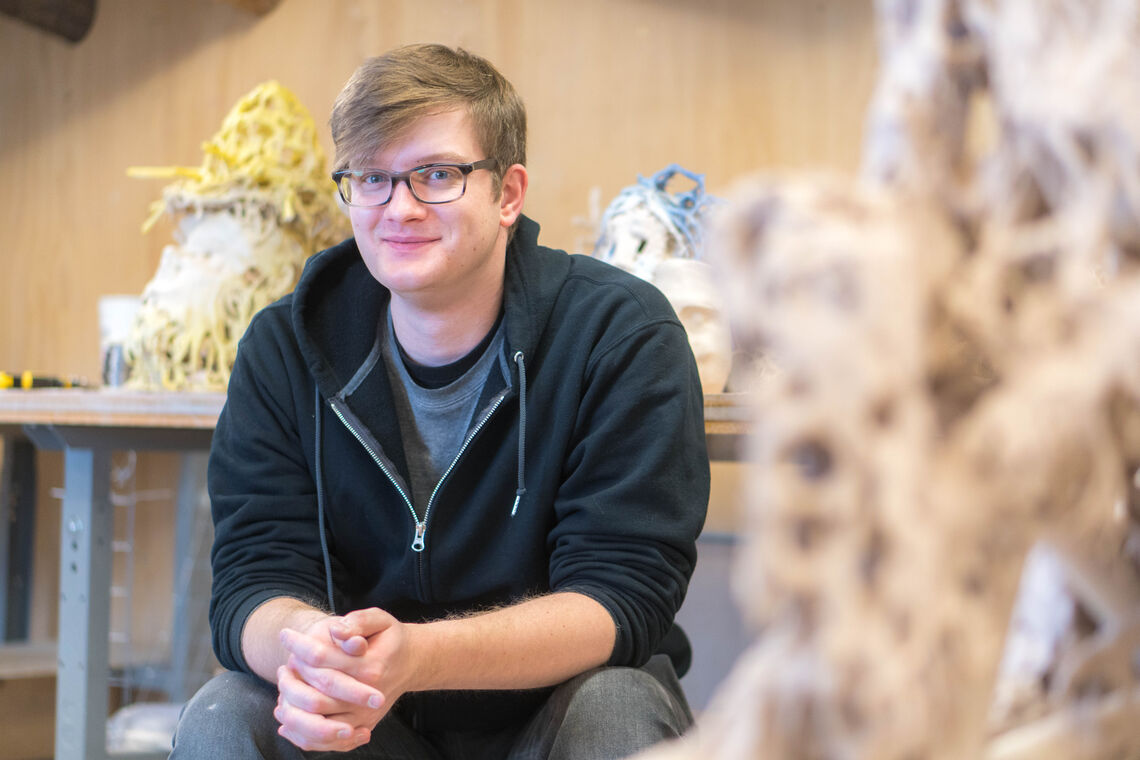Peter Barbor: Falling Short of Heaven
Jul 2nd - Aug 21st, 2021
Inspired by the Edward Hicks paintings of the Peaceable Kingdom, Peter Barbor is exploring the myth of the founding of America through sculptures of the peaceful animals and their chimeric counterparts, using ceramic and other materials. Barbor suggests that America itself is a chimera, with a body made of disparate parts, fighting with each other, and threatening to destroy itself from within. At the same time, an optimism Barbor attributes to his Pennsylvania roots, explains his desire to unpack and understand the distortion of the peaceful scene Hicks imagines, in order to attempt to keep moving toward the ideal. If we illustrate how our society is falling short of heaven, perhaps we can determine how to get closer.
Artist Statement:
Falling Short of Heaven is both a reaction to current events and a reflection on the mortality of American mythologies. Borrowing from Edward Hicks’ paintings of The Peaceable Kingdom, I explored the idea of America as a chimera. A chimera may be either a mythological beast with a lion’s head, a goat’s body, and a serpent’s tail, or something that is illusory or impossible to achieve. The work in this show contrasts Hicks’ idyllic imagery with our present circumstances. While the show includes no actual monsters, each animal is, in a way, a material chimera. Built of straw, raw clay, plaster, and fiber, the work sustains an image while simultaneously being at odds with its own composition.
A straw man replaces the child figure from The Peaceable Kingdom. He passively holds an artificial olive branch while viewing the animal images surrounding him. Through the symbol of the straw man, I aim to critique how present politics uses idealized figures from history, like the mythologized "Founding Fathers," as a sort of straw man's fallacy to stymie progress. To further draw from the many definitions and materiality of a straw man, I raise the possibility that our legacy may be something of diminished integrity or substance. The paradise depicted in Hicks’ paintings is little more than fiction, if not early American propaganda. Like a straw man, the narratives concerning America’s past are perhaps more porous and tenuous than we often believe.
In the past year, we collectively have withstood a global pandemic, a vicious election cycle, and a shared anxiety that America’s promises of freedom and equality are in peril. Hicks’ work proposed optimism for America, constellating his Quaker faith with William Penn’s treaty with the Lenni Lenape and with the biblical scripture from Isaiah 11:6-9.[1] The migration of Europeans to the new world never resulted in the chimeric utopia that Hicks may have envisioned. Sadly, the occupation of indigenous land and the unrelenting westward expansion of the United States came at the expense of Native American lives and culture. As the United States shies away from meaningful acts of truth and reconciliation with those it has harmed, it falls short of its founding ideals. Hicks’ concept of heaven on Earth is certainly not my own, but it approaches a kinder alternative to the dissonant present we endure.
[1]6 The wolf will live with the lamb, the leopard will lie down with the goat, the calf and the lion and the yearling [1] together; and a little child will lead them. 7 The cow will feed with the bear, their young will lie down together, and the lion will eat straw like the ox. 8 The infant will play near the hole of the cobra, and the young child put his hand into the viper's nest. 9 They will neither harm nor destroy on all my holy mountain, for the earth will be full of the knowledge of the LORD as the waters cover the sea.


Bos Taurus
Medium & Materials:
Raw Clay, Hydrocal, Polyester Fiber, Straw, Burlap, Steel, Pine, Pigment, Charcoal
Measurements:
43 x 25 x 11
Date:
2021
Description:
mixed media wall hanging


Panthera Pardus
Medium & Materials:
Raw Clay, Hydrocal, Polyester Fiber, Straw, Burlap, Steel, Pine, Pigment, Charcoal
Measurements:
25 x 43 x 12
Date:
2021
Description:
mixed media wall hanging


Capra Hircus
Medium & Materials:
Raw Clay, Hydrocal, Polyester Fiber, Straw, Burlap, Steel, Pine, Pigment, Charcoal
Measurements:
25 x 43 x 10
Date:
2021
Description:
mixed media wall hanging


Canis Lupus
Medium & Materials:
Raw Clay, Hydrocal, Polyester Fiber, Straw, Burlap, Steel, Pine, Pigment, Charcoal
Measurements:
43 x 43 x 10
Date:
2021
Description:
mixed media wall hanging


Ovis Aries
Medium & Materials:
Raw Clay, Hydrocal, Polyester Fiber, Straw, Burlap, Steel, Pine, Pigment, Charcoal
Measurements:
43 x 43 x 10
Date:
2021
Description:
mixed media wall hanging


Panthera Leo
Medium & Materials:
Raw Clay, Hydrocal, Polyester Fiber, Straw, Burlap, Steel, Pine, Pigment, Charcoal
Measurements:
43 x 25 x 11
Date:
2021
Description:
mixed media wall hanging


Events

Friday, July 2 | 5:00 pm - 7:00 pm
Opening Reception - First Friday
Join us in person at The Clay Studio Gallery to celebrate Peter Barbor's solo exhibition. The Artist and Curator will give short remarks at 5:30.
Sign up for our newsletter.
Stay up to date on all things Clay Studio with announcements, invitations and news delivered straight to your inbox.



























